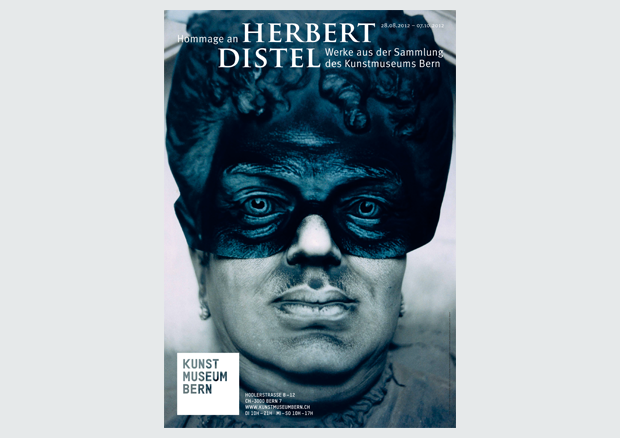Herbert Distel. An Homage with Works from the Collection, 28.08. – 07.10.2012
Delight in Variety and Experiment
To celebrate the 70th birthday of Bern artist Herbert Distel (b. 1942), the Kunstmuseum Bern is presenting an homage to this versatile contemporary artist. As a painter, filmmaker, sculptor, video and sound, installation and conceptual artist, Herbert Distel experiments with a highly diverse range of media. Projekt Canaris (Canaris project, 1970) and Das Schubladenmuseum (The museum of drawers, 1970-1977) are counted among his most famous artworks or events. The works exhibited from the Kunstmuseum Bern’s collection cover all the different phases of the artist’s career and offer a small but concentrated overview of his oeuvre.
The egg that crossed the Atlantic
With its deeper meaning, Projekt Canaris commands a central position within the homage: In 1970, Herbert Distel organized the Atlantic crossing of a three-meter long egg made of polyester and fitted out with a camera. He launched the artwork on June 10, 1970, at the most western point of the Canary Islands, hoping that the ocean currents and Atlantic winds would transport it to some coastline in the Caribbean or the shores of Central America. The egg was finally discovered on February 24, 1971, on the north coast of Trinidad, where very strong winds had crushed it on rocks. Preparing the event involved the participation of highly diversified specialists and individuals who had nothing to do with art. Cooperation with the various scientists in conjunction with Projekt Canaris may not necessarily have been a novel thing, but the role played by a PR agency in marketing the event definitely was. Therefore Herbert Distel is one of the first artists to have integrated the organization and management of an art event as an essential part of the work itself and is a pioneer in guiding the reception of art independent of a museum. The whole process, right up to realizing the event, is reflected in various works: The Landkarte (Map, 1970) lists—as calculated by the German Meteorological Service for Shipping of Hamburg University—the probable route, the drift of the currents and expected duration, as well as the corresponding destinations for the different times at which the egg could be set afloat. The film produced by WDR in 1970 shows the journey of the egg from Switzerland to its being set adrift. An overview of the extensive correspondence resulting from the planning stage as well as the great response to and popularity of the event can be found in a file containing documents, letters, photographs, and newspaper reports from 1969 to 1974.
Early sculptures, photographs, and films
Distel’s early work is marked by his fondness for experimentation with the medium of sculpture. At first he made white sculptures, but from 1965 onwards he also began to use colors. With the malleable and easy to manipulate newly introduced product polyester, a plastic that was introduced to the market at the time, Herbert Distel found a neutral material with which he could achieve the desired perfection that was essential for flawless form and color. Without a pedestal and set directly on the ground, the colored sculptures of elementary forms have a suggestive force of expression and influence our perception of space.
Besides sculptures made of polyester (1965-1970), the Kunstmuseum Bern is also showing photographic works from the 1990s as well as films. One of the subjects that repeatedly fascinated Herbert Distel was the fictive quality of human existence. This can be clearly discerned in his self-portrait Werde, der du bist (Become who you are), a photograph made in 1992. Here too we can witness the artist's versatility and delight in experimentation, again and again enticing him to use new materials and media to implement his ideas in art.
Since 1974 Distel has been exploring film and video. In conjunction with the exhibition visitors have the opportunity of viewing Layla in Camp, Majnun lying without (1975), Die Reise (The journey, 1987), the collage of recycled video images die angst die macht die bilder des zauberlehrlings (the fear the power the imagery of the sorcerer’s apprentice, 1987–1993), which won many prizes as well as the recently finished video DENK MAL (Think monument, 2007-2012).
Herbert Distel’s short films in the Kino Kunstmuseum
In conjunction with the exhibition, the Kunstmuseum's cinema Kino Kunstmuseum will be showing on September 1 and 2 Distel’s short films Das Telefon (The telephone, 1977), in which a woman loses half her body weight in six minutes, Marrons Glacés (Glazed chestnuts,1981), Jimmy (1982) and others.
Contact person: Brigit Bucher, , T +41 31 328 09 21
Images: Marie Louise Suter, , T +41 31 328 09 53


